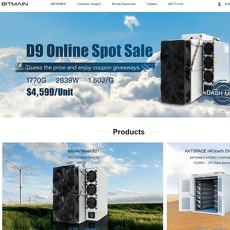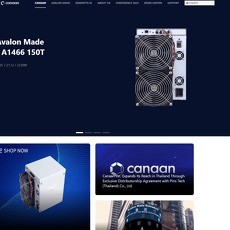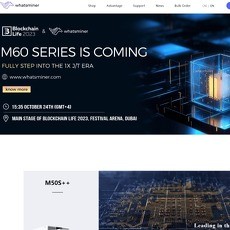Bitcoin mining hardware and Cryptocurrency mining rigs
The Untold Secrets of Mining Hardware
If you've landed on this article, you're probably itching to know everything about mining hardware. And not just the same-old stuff everyone regurgitates – I’m talking about the deep, gritty, and juicy details that only a cool guy like me would spill. So, buckle up, my tech-savvy friend, because we're about to embark on a wild ride.
Unmasking the Hype: What Really is Mining Hardware?
We've all heard the buzz: "Crypto is the future!" and "Mining is the new gold rush!" But what's behind all this? Yep, you guessed it: mining hardware. These are the powerful machines that crunch numbers day in and day out, securing the blockchain and making sure that Bitcoin, Ethereum, and other cryptocurrencies remain decentralized and tamper-proof.
Evolution of the Beasts: From CPUs to ASICs
Remember the early days when any regular Joe with a computer could mine some Bitcoin? Ah, the good times. The key player then? The CPU (Central Processing Unit). But like all good things, it had to evolve. Then came the GPUs (Graphics Processing Units) – kind of like CPUs on steroids. Gamers know these bad boys well; after all, they make your games look pretty. But they also proved to be champs at hashing out those crypto algorithms. But the world of crypto is cutthroat, and soon enough, the FPGA (Field-Programmable Gate Array) entered the scene. Faster and more efficient, but not the end of the line. Enter the ASIC (Application-Specific Integrated Circuit) – a device specifically built for mining. They're the big guns, the apex predators of the mining world. These devices are designed for one purpose: to mine crypto, and they do it well.
Choosing the Right Tool: Mining Hardware Options
ASIC Miners: If you're serious about mining, especially Bitcoin, then ASICs are your best bet. They're super powerful, but they're also power-hungry, so keep those electricity bills in mind. GPU Rigs: Ideal for altcoins and those who might also want to play a game or two when not mining. Versatile and easier to sell if you ever hang up your mining hat. Cloud Mining: Not into getting your hands dirty? Cloud mining might be your alley. No hardware required, but be wary of scams and always do thorough research.
Power vs. Profit: The Eternal Struggle
It ain't all sunshine and rainbows in the mining world. As powerful as these machines are, they're also energy vampires. Your potential profits can quickly get swallowed by electricity costs if you're not careful. Always do the math before diving in.
The Future of Mining Hardware: Quantum Computing?
Crypto's always evolving, and with the buzz around quantum computing, one can't help but wonder: will these supercomputers be the next big thing in mining? It's too early to tell, but always keep an eye on the horizon. The world of crypto and mining is full of surprises.
Wrapping It Up Like a Pro
So there you have it – a cool guy's guide to mining hardware. From the humble CPU days to the monstrous ASIC beasts, the journey's been wild. If you're thinking of diving into the mining world, remember: always do your research, watch those electricity bills, and keep an ear to the ground for the next big thing. And hey, if you found this article useful, give it a share. Google's got nothing on us. Stay cool, stay savvy, and always mine responsibly!
FAQ on Mining Hardware
What is mining hardware?
Mining hardware refers to specialized computer equipment used to solve complex mathematical problems, a process vital in verifying and adding cryptocurrency transactions to a public ledger known as the blockchain.
What are the main types of mining hardware?
The primary types are CPUs (Central Processing Units), GPUs (Graphics Processing Units), FPGAs (Field-Programmable Gate Arrays), and ASICs (Application-Specific Integrated Circuits).
What's the difference between GPU and ASIC mining?
GPU mining uses graphics cards designed for gaming, making it versatile for mining various cryptocurrencies. ASIC mining, on the other hand, uses hardware specifically designed for mining a particular cryptocurrency, making it more efficient but less flexible.
Is mining still profitable in 2023?
A: Profitability depends on several factors including electricity costs, hardware efficiency, and the current value of the cryptocurrency being mined. It's essential to do a thorough cost-benefit analysis before starting.
How do I choose the best mining hardware for my needs?
Consider factors like the cryptocurrency you want to mine, your budget, electricity rates, and how tech-savvy you are. ASICs offer high efficiency but are more expensive and limited to specific coins. GPUs are more versatile but might be less efficient.
Can I mine with my personal computer?
While it's technically possible, using a standard PC for mining can be slow and inefficient. It also puts a strain on your device, potentially shortening its lifespan.
What's the role of electricity costs in mining?
Mining hardware consumes a lot of power. High electricity costs can eat into potential profits, making mining less lucrative or even unprofitable in areas with high energy rates.
What is cloud mining?
Cloud mining involves renting mining power from a company with large mining farms, eliminating the need to buy and maintain your own hardware. However, there are risks of scams, so always research before committing.
How do I ensure my mining hardware stays cool?
A: Proper ventilation, using cooling systems like fans or even specialized cooling solutions, and ensuring your hardware isn't placed in a confined space can help prevent overheating.
Are there environmental concerns with cryptocurrency mining?
Yes, the high energy consumption of large-scale mining operations has raised environmental concerns, especially when non-renewable energy sources are used.
Pros of Mining Hardware:
- Profit Potential: With the right setup and market conditions, mining hardware can generate significant profits, especially during cryptocurrency price surges.
- Supporting Decentralization: Miners play an integral role in decentralizing cryptocurrency networks, making them resistant to censorship and centralized control.
- Hardware Choices: Different options, such as ASICs, GPUs, and FPGAs, offer flexibility depending on the miner's goals and the cryptocurrency they want to mine.
- Economic Stimulus: Mining operations can boost local economies by creating jobs, especially in regions with cheaper electricity.
- Transaction Verification: Mining hardware helps verify and add transactions to the blockchain, increasing security and trust in the system.
- Potential for Passive Income: Once set up, mining rigs can operate 24/7, generating potential income around the clock (though maintenance and monitoring are still required).
- Tech Advancements: The demand for more efficient mining hardware has driven technological advancements, benefiting even industries outside of cryptocurrency.
Cons of Mining Hardware:
- High Initial Costs: Setting up a mining rig, especially with top-tier equipment, can be expensive. ROI isn't always guaranteed.
- Electricity Consumption: Mining consumes significant electricity, leading to high operational costs, especially in regions where power isn't cheap.
- Obsolescence Risk: With the rapid evolution of technology, mining hardware can become outdated relatively quickly, especially ASIC miners that are cryptocurrency-specific.
- Environmental Concerns: Large-scale mining operations, especially those powered by non-renewable energy, contribute to environmental degradation.
- Heat and Noise: Mining rigs produce significant heat and noise, which can pose challenges in residential settings.
- Technical Challenges: Setting up and maintaining a mining rig requires a certain level of technical knowledge, which may not be suitable for everyone.
- Market Volatility: The profitability of mining is tied to cryptocurrency market prices, which are notoriously volatile. A price drop can swiftly make mining unprofitable.
- Regulatory Issues: Some countries have regulations or outright bans on cryptocurrency mining due to various concerns, making it a risky venture in certain jurisdictions.
In summary, while mining hardware has the potential for profit and plays a crucial role in the cryptocurrency ecosystem, it's essential to weigh the advantages against the drawbacks. Prospective miners should do thorough research and calculations before diving into the venture.



